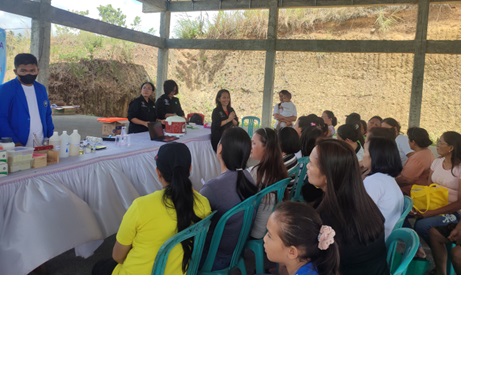Pemberdayaan Masyarakat melalui Pelatihan Pengolahan dan Pemanfaatan Bawang Putih Fermentasi untuk Pengobatan Penyakit Degeneratif Community Empowerment through Training on the Processing and Utilization of Fermented Garlic for the Treatment of Degenerative Diseases
Main Article Content
Abstract
People in Silian I Village have a relatively high level of meat consumption, which can trigger various degenerative diseases. To treat their illnesses, people use more modern medicines than traditional medicines. Garlic helps treat various diseases and has been used as a traditional medicine. Fermented Garlic (Black Garlic) has been developed in several countries. The secondary metabolite content in Fermented Garlic is higher than in regular Garlic, so the resulting properties are also more potent. This activity aims to provide training to the public regarding the processing and use of Fermented Garlic (Black Garlic) to treat degenerative diseases. Activities include training on processing Garlic into Fermented Garlic (Black Garlic) and its use in making processed food preparations and counseling regarding licensing procedures for producing processed food. Evaluation of the activity showed increased community knowledge about the processing and use of Black Garlic for treating degenerative diseases after the activity. The community enthusiastically participated in the activity and was interested in making and using it to help treat the degenerative diseases they suffered.
Downloads
Article Details

This work is licensed under a Creative Commons Attribution-ShareAlike 4.0 International License.
Authors who publish with this journal agree to the following terms:
- Any article on the copyright is retained by the author(s).
- Author grant the journal, right of first publication with the work simultaneously licensed under a Creative Commons Attribution License that allows others to share work with acknowledgment of the work authors and initial publications in this journal.
- Authors are able to enter into a separate, additional contractual arrangements for non-exclusive distribution of published articles of work (eg, post-institutional repository) or publish it in a book, with acknowledgment of its initial publication in this journal.
- Authors are permitted and encouraged to post their work online (e.g., in institutional repositories or on their websites) prior to and during the submission process, as can lead to productive exchanges, as well as earlier and greater citation of published work.
- The article and any associated published material is distributed under the Creative Commons Attribution-ShareAlike 4.0 International License
References
Annis, A., Salisa, W., Raudhany, F.A., Tawakal, I., Rachmawati, H., Isaura, E.R., Farapti, Sutthiwong, N. (2023). Analisis Usaha Makanan Fungsional Fermented Garlic dengan Metode Canvas Model Bagi Komunitas Lansia Non Produktif. Jurnal Layanan Masyarakat. 6(2): 347-354.
Botas, J., Fernandes, A., Barros, L., Alves, M.J., Carvalho., Fereira, I.C.F.R. (2019). A Comparative Study of Black and White Allium sativum L.: Nutrional Composition and Bioactive Properties. Jurnal Molecules. 24: 1-11. https://doi.org/10.3390/2Fmolecules24112194
Fatihaturahmi., Yuliana., & Yulastri, A. (2023). Literature Review : Penyakit Degeneratif : Penyebab, Akibat, Pencegahan Dan Penanggulangan. JGK Jurnal Gizi dan Kesehatan 3(1):63-72. http://dx.doi.org/10.36086/jgk.v3i1.1535
Habib, M.A.F. (2021). Kajian Teoritis Pemberdayaan Masyarakat dan Ekonomi Kreatif. Ar Rehla: Journal of Islamic Tourism, Halal Food. Islamic Traveling, and Creative Economy. 1(2): 82–110.
Harini, N., Suhariyanto, D., Indriyani, Novaria, N., Santoso, A., Yuniarti, E. (2023). Pendampingan Pemberdayaan Masyarakat Dalam Meningkatkan Perekonomian Desa. Amalee Indonesian Journal of Community Research and Engagement. 4(2): 363-375 https://doi.org/10.37680/amalee.v4i2.2834
Karwiti, W., Rezekiyah, S., Nasrazuhdy, Lestari, W, S., Nurhayati., & Asrori. 2023. Profil Kimia Darah sebagai Deteksi Dini Penyakit Degeneratif Pada Kelompok Usia Produktif. Jurnal Kesehatan Komunitas ( Journal of Community Health). 9(3) : 494-503. https://doi.org/10.25311/keskom.Vol9.Iss3.1389
Pulungan, M.H., Santoso, EFSM., Sukardi, Purwaningsih, I. (2022). Pelatihan Pembuatan Minuman dan Makanan Camilan Fungsional dan Bawang Hitam. Jurnal Pengabdian dan Pemberdayaan Masyarakat. 6(1):177-181. http://dx.doi.org/10.30595/jppm.v6i1.7664
Widhiastuti, S. S. (2020). Aplikasi Media Terkondisi Sel Punca Mesensimal dalam Terapi Penyakit Degeneratif dan Penyembuhan Luka. Biota : Jurnal Ilmiah Ilmu-Ilmu Hayati, 5(1), 48–60. https://doi.org/10.24002/biota.v5i1.2963
